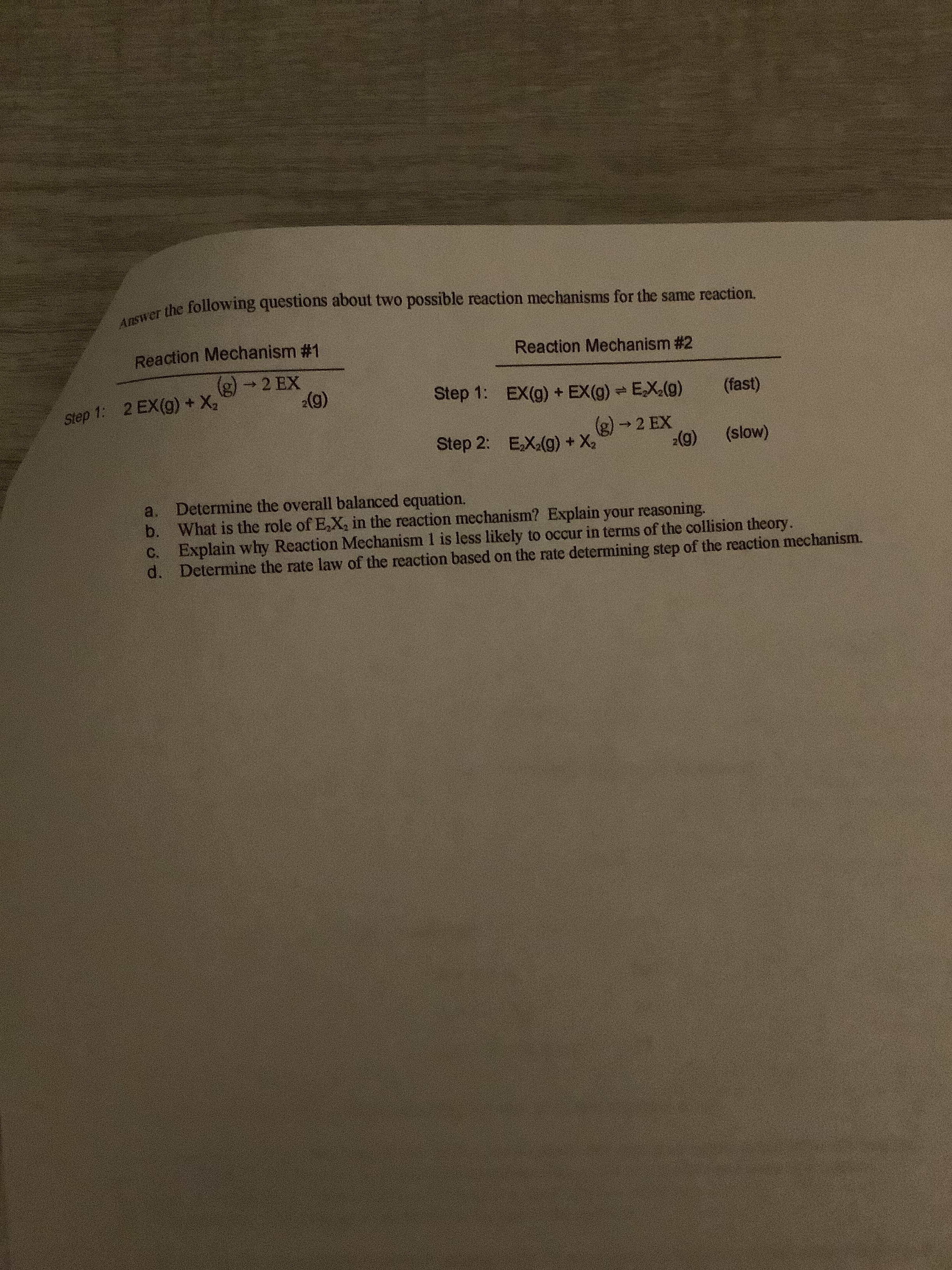Answer the following questions about two possible reaction mechanisms for the same reaction. Reaction Mechanism #1 Reaction Mechanism #2 (g) →2 EX 2(g) Step 1: 2 EX(g) + X, Step 1: EX(g) + EX(g) EX(g) (fast) Step 2: EX(g) + X2 (g) → 2 EX 2(g) (slow) a. Determine the overall balanced equation. b. What is the role of E,X, in the reaction mechanism? Explain your reasoning. C. Explain why Reaction Mechanism 1 is less likely to occur in terms of the collision theory. d. Determine the rate law of the reaction based on the rate determining step of the reaction mechanism.
Answer the following questions about two possible reaction mechanisms for the same reaction. Reaction Mechanism #1 Reaction Mechanism #2 (g) →2 EX 2(g) Step 1: 2 EX(g) + X, Step 1: EX(g) + EX(g) EX(g) (fast) Step 2: EX(g) + X2 (g) → 2 EX 2(g) (slow) a. Determine the overall balanced equation. b. What is the role of E,X, in the reaction mechanism? Explain your reasoning. C. Explain why Reaction Mechanism 1 is less likely to occur in terms of the collision theory. d. Determine the rate law of the reaction based on the rate determining step of the reaction mechanism.
Chemistry & Chemical Reactivity
9th Edition
ISBN:9781133949640
Author:John C. Kotz, Paul M. Treichel, John Townsend, David Treichel
Publisher:John C. Kotz, Paul M. Treichel, John Townsend, David Treichel
Chapter14: Chemical Kinetics: The Rates Of Chemical Reactions
Section14.5: A Microscopic View Of Reaction Rates
Problem 2RC
Related questions
Question

Transcribed Image Text:Answer the following questions about two possible reaction mechanisms for the same reaction.
Reaction Mechanism #1
Reaction Mechanism #2
(g) →2 EX
2(g)
Step 1: 2 EX(g) + X,
Step 1: EX(g) + EX(g) EX(g)
(fast)
Step 2: EX(g) + X2
(g) → 2 EX
2(g)
(slow)
a. Determine the overall balanced equation.
b. What is the role of E,X, in the reaction mechanism? Explain your reasoning.
C. Explain why Reaction Mechanism 1 is less likely to occur in terms of the collision theory.
d. Determine the rate law of the reaction based on the rate determining step of the reaction mechanism.
Expert Solution
This question has been solved!
Explore an expertly crafted, step-by-step solution for a thorough understanding of key concepts.
This is a popular solution!
Trending now
This is a popular solution!
Step by step
Solved in 4 steps

Knowledge Booster
Learn more about
Need a deep-dive on the concept behind this application? Look no further. Learn more about this topic, chemistry and related others by exploring similar questions and additional content below.Recommended textbooks for you

Chemistry & Chemical Reactivity
Chemistry
ISBN:
9781133949640
Author:
John C. Kotz, Paul M. Treichel, John Townsend, David Treichel
Publisher:
Cengage Learning

Chemistry for Engineering Students
Chemistry
ISBN:
9781337398909
Author:
Lawrence S. Brown, Tom Holme
Publisher:
Cengage Learning

Chemistry & Chemical Reactivity
Chemistry
ISBN:
9781337399074
Author:
John C. Kotz, Paul M. Treichel, John Townsend, David Treichel
Publisher:
Cengage Learning

Chemistry & Chemical Reactivity
Chemistry
ISBN:
9781133949640
Author:
John C. Kotz, Paul M. Treichel, John Townsend, David Treichel
Publisher:
Cengage Learning

Chemistry for Engineering Students
Chemistry
ISBN:
9781337398909
Author:
Lawrence S. Brown, Tom Holme
Publisher:
Cengage Learning

Chemistry & Chemical Reactivity
Chemistry
ISBN:
9781337399074
Author:
John C. Kotz, Paul M. Treichel, John Townsend, David Treichel
Publisher:
Cengage Learning


Chemistry: An Atoms First Approach
Chemistry
ISBN:
9781305079243
Author:
Steven S. Zumdahl, Susan A. Zumdahl
Publisher:
Cengage Learning

Chemistry
Chemistry
ISBN:
9781305957404
Author:
Steven S. Zumdahl, Susan A. Zumdahl, Donald J. DeCoste
Publisher:
Cengage Learning